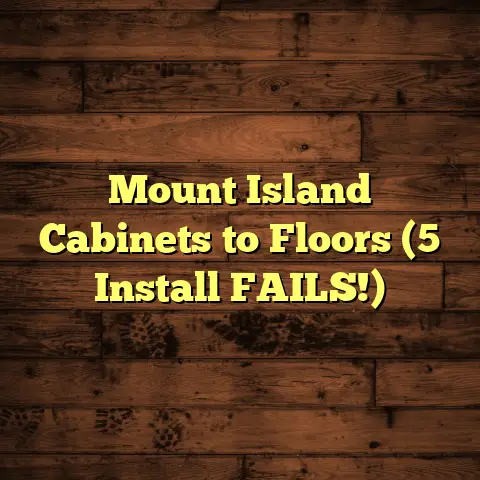How Much Does Kitchen Flooring Cost (Explained)
When considering a kitchen renovation, one of the most impactful decisions you’ll make is the choice of flooring.
Kitchen flooring not only affects the aesthetics of the space but also its functionality and durability.
This comprehensive guide will break down the costs associated with installing hardwood flooring, provide insights into various factors affecting pricing, compare hardwood with alternative flooring options, and offer tips for maintenance.
Overview of Major Cost Factors
1. Area Size
The size of the area to be floored is one of the primary determinants of cost.
Larger spaces will require more materials and labor, leading to higher overall expenses.
2. Hardwood Type
Different species of hardwood come with varying price points. Common types include:
- Oak: A popular choice due to its durability and affordability.
- Maple: Slightly more expensive, known for its fine grain.
- Cherry: Offers a rich color but can be on the pricier side.
- Walnut: A premium option that adds elegance but comes with a higher cost.
3. Labor Costs
Hiring a professional installer is often advisable for hardwood flooring due to the complexity involved.
Labor costs can vary based on the region, the installer’s experience, and the project’s scope.
4. Additional Considerations
- Floor Removal: If you’re replacing existing flooring, removal can add to your costs.
- Subfloor Replacement: Damaged subfloors may need replacement, incurring additional expenses.
- Material Grade: Higher-grade wood will cost more but may offer better durability and aesthetics.
- Room Size/Layout: Irregular layouts can complicate installation and increase labor costs.
- Installation Type: Different installation methods (nail-down, glue-down, floating) can have different costs associated.
Detailed Cost Breakdown
Below is a detailed breakdown of costs associated with hardwood flooring installation for various project sizes and types:
Hardwood Types & Grades
Installation Types
- Nail-down: Generally ranges from $4 to $8 per sq ft.
- Glue-down: Can cost between $6 and $10 per sq ft.
- Floating: Typically around $3 to $6 per sq ft.
Comparison with Alternative Flooring Options
1. Laminate Flooring
- Cost: $2 – $5 per sq ft.
- Pros: More affordable, easier installation, scratch-resistant.
- Cons: Less durable than hardwood, cannot be refinished.
2. Vinyl Flooring
- Cost: $2 – $7 per sq ft.
- Pros: Water-resistant, versatile design options.
- Cons: Less authentic feel compared to hardwood.
3. Carpet
- Cost: $1 – $5 per sq ft.
- Pros: Comfortable underfoot, good insulation.
- Cons: Difficult to clean in a kitchen setting, not water-resistant.
Signs Your Hardwood Floors Need Replacement
Recognizing when to replace hardwood floors is crucial for maintaining your kitchen’s aesthetic and functionality.
Signs include:
- Severe warping or buckling
- Deep scratches or gouges that cannot be sanded out
- Extensive water damage
- Persistent creaking or squeaking noises
Refinishing vs. Replacement
Refinishing is often a viable option if the floors are structurally sound but show signs of wear.
Consider refinishing if:
- The hardwood can be sanded down without reaching the tongue-and-groove joints.
- The damage is mostly superficial and limited to the finish.
Replacement may be necessary if:
- The floorboards are extensively damaged or rotten.
- You desire a completely different look or wood type.
Pros and Cons of Hardwood Flooring
Pros
- Durability: With proper care, hardwood floors can last for decades.
- Aesthetics: Adds warmth and elegance to any space.
- Value Addition: Homes with hardwood flooring often see an increase in property value.
Cons
- Costly Installation: Higher upfront costs compared to other flooring options.
- Maintenance: Requires regular upkeep to maintain its appearance.
- Susceptibility to Damage: Can be scratched or dented more easily than some alternatives.
Professional Installation vs. DIY
Professional Installation
Hiring professionals typically costs more but ensures:
- Proper installation techniques are used.
- Warranty coverage on workmanship.
- Reduced risk of costly mistakes.
DIY Considerations
While DIY can save money:
- Requires a level of skill and tools (e.g., saws, nail guns).
- Mistakes can lead to additional costs down the line.
Cost Breakdown for DIY
If you opt for DIY, factor in:
- Tools rental/purchase ($50 – $300)
- Materials (same as above)
The total savings might range from 10% to 30%, depending on your skill level and project complexity.
Questions to Ask Hardwood Flooring Contractors
To ensure you select the right contractor for your hardwood floor installation, consider asking the following questions:
- What is your experience with hardwood flooring installations?
- Can you provide references from previous clients?
- What type of warranty do you offer on materials and labour?
- How do you handle unexpected issues during installation?
- What are your payment terms and policies?
Hardwood Floor Care and Maintenance Tips
To maximize the lifespan of your hardwood floors:
- Regularly sweep or vacuum to remove dirt and debris.
- Use a damp mop with a suitable cleaner; avoid excess water.
- Place rugs in high traffic areas to prevent wear.
- Refinish every 5–10 years based on usage.
Conclusion
Investing in hardwood flooring for your kitchen can significantly enhance both its beauty and value.
By understanding the various cost factors, comparing options, and knowing when to refinish or replace your floors, you can make informed decisions that fit your budget and lifestyle.
Whether you choose to hire professionals or tackle the project yourself, maintaining your floors properly will ensure they look stunning for years to come.





